Reservoirs have been around for thousands of years. Basically, a reservoir is an artificial lake or tank that is used to store water for human use. The water we drink, cook with, bathe in ... it pretty much all comes from a reservoir.
In some cases, reservoirs rival the size of some of the world's largest lakes. The biggest reservoir — Lake Kariba in Africa — would be the 26th largest lake by area in the world if it was natural. The Los Angeles Reservoir is nowhere near that big, but it does have something that Kariba doesn't.
These.
No, you're not witnessing a truck driver accidentally dumping the ball pit shipment for the local carnival into the reservoir. This was exactly what was supposed to happen. Those are shade balls. And they're a terrific example of some of the peculiar solutions being tested to everyday problems.
Problems and solutions
A reservoir outside Cape Town, South Africa. (Getty Emebd)
Any open air reservoir like the Los Angeles Reservoir has a few issues to address to keep its water drinkable. For one, algae, bacteria, and other viruses can all grow in still (non-flowing) water. Yuck. Birds can, well, poop in an open air pool. Double yuck. Plus, constant sunlight can lead to evaporation.
A common solution to these problems begins with lightly chlorinating the water — this kills algae, bacteria, and so forth. But chlorine also had a nasty side effect in open air reservoirs. This water has a compound in it called bromine, which is harmless, but ... Chlorine plus sunlight turns bromine into bromate. And while bromate sounds like a person that everyone would love to hang out with (Bro! Mate!), it's actually a potentially cancer-causing agent. Ugh.
All of this leads to the next part of the solution: Covering the water to block out the sunlight and reduce evaporation. Seems straight forward enough, except that reservoirs like the LA Reservoir are huge. A roof over that thing would cost over $300 million dollars! While a trap, like what people have over their swimming pools, would probably just become a perch for birds, which still runs a risk of contamination.
Having a ball
So many balls! (Getty Emebd)
The shade balls are meant to address all of these problems at once. And the more you learn about them, they're quite ingenious.
They cover the water, which both reduces evaporation and stops bromate from forming below. In fact, less chlorine is required to treat the water than without them.
Their round shape means that birds don't like to land on them (since they keep spinning), so no feather-borne diseases get in the water.
They're made of food-grade plastic, which means that you could even eat one and be fine (don't do it, please).
And what's more, their carbon black colour makes them durable — even in direct sunlight, they won't break down for ten years or more.
So 80% to 90% less evaporation? Less chlorination? No birds? What's not to like about shade balls?
Bailing on balls?
This piece of art by Canadian artist Benjamin Von Wong highlights the negative ways that plastic has invaded our water. (Getty Emebd)
Well, for one, as you may have heard, water and plastic aren't exactly awesome together. So despite efforts to make these balls durable and non-toxic, some people are never going to be comfortable with the idea of millions of plastic balls in their drinking water.
And when we say millions, we mean millions. The Los Angeles Reservoir requires 96 million shade balls to cover its surface. That's a lot of plastic that needs to be made — a process that uses, you guessed it, water. A recent study has shown that while the LA shade balls prevented the evaporation of 1.7 million cubic metres of water over a 20-month period, they required 2.9 million cubic metres of water to make.
In short, the balls needed to be used for about three years before they could "break even" in terms of water used versus water saved. And while the balls are cheaper than a roof, they're not cheap. Those 96 million balls cost about $34 million. Are they really a better investment than a permanent roof?
In the end, the case of shade balls just goes to show that solutions like this take time to perfect. Do you think shade balls will eventually prove to be the best way to keep our water protected?
 Millions upon millions of black plastic balls are sitting on the water's surface at the Los Angeles Reservoir. The questions is: Why? (Wikimedia Commons/Junkyardsparkle)
Millions upon millions of black plastic balls are sitting on the water's surface at the Los Angeles Reservoir. The questions is: Why? (Wikimedia Commons/Junkyardsparkle)










Since plastic does not break down for many years perhaps it is the answer for it’s usefulness in the better good!
Hi!!! I am just wondering what happened in during the winter time while using shade balls. As you know, some countries are very cold during the winter time.
In cold climates I don’t think evaporation is much of an issue. Also algae growth is is much less. Just filter out the bird poop and it’s good to go. In warmer climates, I’ve heard of covering smaller lakes with solar panels. It seems much better than plastic.